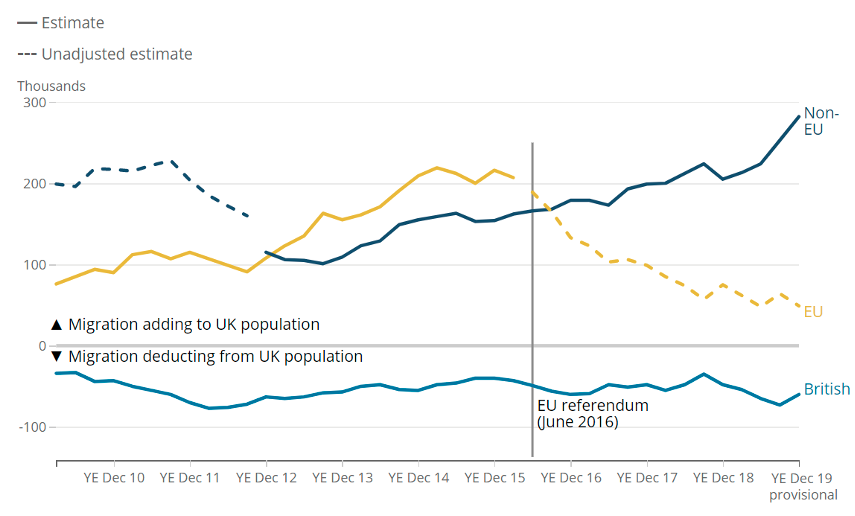Immigration was central to the politics of Brexit (Hobolt 2016), but was peripheral in the pre-referendum discussion of its economic consequences (Portes 2016). Indeed, both before and in the immediate aftermath of the referendum, the UK’s choice was often framed as a tradeoff between the economic costs of increasing trade frictions between the UK and EU on the one hand, and the political benefits of ending free movement and restoring ‘control’ over immigration on the other (e.g. Baldwin et al. 2016).
Since the referendum this has reversed – immigration has become a much less salient political issue, and public attitudes towards immigration have become more positive (Runge 2019). However, its economic significance has become more apparent, first as migration flows from the EU fell sharply and then, in the past year, as the COVID-19 pandemic has led to very large net outflows. Forte and Portes (2017) forecasted that net EU migration could fall by up to 150,000 over the period between 2016 and 2020. These forecasts have proved broadly accurate. As Figure 1 below – from the last set of published migration statistics, before the pandemic made collecting them impossible – shows, net EU migration did indeed fall by slightly more than 150,000 by the end of 2019.
Figure 1 Net migration by citizenship, UK, year ending March 2010 to year ending December 2019
Source: UK Office for National Statistics, 2020
At the same time, there was also a significant rise in non-EU migration, facilitated by government policy, with the cap on Tier 2 visas for non-EU migrants (that is, relatively skilled or highly paid workers) being relaxed. This marked the end of the Theresa May era in immigration policy, during which the overriding objective of immigration policy had been to reduce numbers. It is against this background that the UK is introducing the new, post-Brexit immigration system. In a new paper (Portes 2021), I discuss the new system, and outline some of the potential implications.
As I set out in Portes (2020), this system was shaped by two broad forces. First, the government’s commitment to ending free movement and moving to an ‘Australian-style’ points system, which would treat EU and non-EU migrants similarly. As a result, the UK-EU Trade and Cooperation Agreement contains very limited provisions on labour mobility. But second, significant shifts in both public opinion and government policy towards immigration in general. Opinion polls suggest that voters have simultaneously become both much less concerned about immigration and much more positive about its impacts (Runge 2019). Moreover, the replacement of Theresa May, who had been a notably restrictionist Home Secretary, with Boris Johnson, who had adopted relatively liberal positions on immigration during his tenure as Mayor of London, signalled a change in the relative priorities within government attached to the economic benefits of immigration compared to the political need to be seen to be controlling it.
The policy intent of the new system is therefore less about reducing migration, and more about making it both more diverse (in a geographic sense) and more selective (in relation to the skill level of workers). Free movement ends and the new system will apply to all those moving to the UK to work, apart from Irish citizens. EU (and EEA/Swiss) nationals already resident in the UK are able to apply to remain indefinitely under the “settled status” scheme, and most have already done so.
The key provisions of the new system are that:
- new migrants should be coming to work in a job paying more than £25,600 or the lower quartile of the average salary, whichever is higher, and in an occupation requiring skills equivalent to at least A-levels (“RQF3”);
- there will be a lower initial threshold for new entrants and for those in shortage occupations, meaning that for some occupations the salary threshold may be as low as about £20,000;
- there will also be a lower threshold for those with PhDs, especially in STEM subjects;
- for the National Health Service and education sectors, there will in effect be no salary threshold. If the job is at an appropriate skill, then paying the appropriate salary according to existing national pay scales will be sufficient;
- there will be an expanded Seasonal Agricultural Workers Scheme, but no other sectoral schemes for workers who do not meet the skill threshold.
The new system will represent a very significant tightening of controls on EU migration compared to free movement. Migrants coming to work in lower-skilled and paid occupations will in principle no longer be able to gain entry. Even those who do qualify will need their prospective employers to apply on their behalf, will have to pay significant fees, and will, as is the case for non-EU migrants at present, have significantly fewer rights, for example in respect of access to the benefit system.
However, compared to the current system, the new proposals represent a considerable liberalisation for non-EU migrants, with lower salary and skill thresholds, and no overall cap on numbers. Approximately 68% of UK employees work in occupations requiring RQF3 level skills or above. Given the requirement for new migrants to be paid at or above the lower quartile of earnings for that occupation, that implies about half of all full-time jobs would be in principle qualify an applicant for a visa. This represents a very substantial increase – perhaps a doubling compared to the previous system for non-EU nationals, which was also for most of the 2012-19 period subject to an overall quota and a resident labour market test. It also makes the new system considerably more liberal with respect to non-European migrants than that of most EU member states, which typically apply much more restrictive (de facto and/or de jure) skill or salary thresholds, and often enforce a resident labour market test.
So, it is not the case that the new system represents an unequivocal tightening of immigration controls. Rather, it rebalances the system from one which was essentially laissez-faire for Europeans, while quite restrictionist for non-Europeans, to a uniform system that, on paper at least, has relatively simple and transparent criteria, and covers up to half the UK labour market.
In Portes (2021), I discuss the potential economic impacts. The key point is that economists’ views – including my own – on the potential impacts on the UK economy of the end of free movement and the transition to the new system may have been too pessimistic, based as they were on the assumption the new system would be more restrictive. For example, Forte and Portes (2019) estimated that the new system would result in a reduction to UK GDP of up to 2% over 10 years. However, updating their estimates to reflect the new system results in a much smaller fall in GDP, and indeed a small rise in GDP per capita.
These estimates do not take account of the broader impacts of migration, in particular on productivity (Portes 2018, Goldin and Nabarro 2018), nor the interaction of Brexit impacts with those of the pandemic and its aftermath. Some sectors may be badly hit – for example, higher education (Amuedo-Dorantes and Romiti 2021), and there are emerging signs of labour and skills shortages in the hospitality sector, as many EU-origin workers appear to have returned to their home countries during the pandemic.
An additional dimension of uncertainty results from the government’s decision to offer entry visas to the almost three million British National Overseas passport holders from Hong Kong, and their dependents. The Home Office’s central forecast of the resulting migration flows (Home Office 2020) is about 300,000 over five years, but its low and high estimates are 10,000 and 1,000,000 respectively. Actual flows will be driven by developments in Hong Kong. If hundreds of thousands of Hong Kong residents do come to the UK, the potential impacts could be transformative.
So considerable uncertainty remains. Nevertheless, while the overwhelming consensus amongst economists that Brexit – and in particular the ‘hard’ Brexit pursued by the UK government – will have significant negative impacts on trade and investment, and hence on the broader UK economy, there is much more cause for optimism about the impacts of the new post-Brexit UK immigration system.
References
Amuedo-Dorantes, C, and A Romiti (2021), “Brexit deterred international students from applying to UK universities”, VoxEU.org, May 15.
Baldwin, R, et al. (2016), “Brexit Beckons: thinking ahead by leading economists”, VoxEU.org, 1 August.
Forte, G, and J Portes (2017), “The economic impact of Brexit-induced reductions in migration to the UK”, VoxEU.org, 5 January.
Forte, G, and J Portes (2019), “Migration to Wales: the impact of post-Brexit policy changes”, Welsh Centre for Public Policy, University of Cardiff, February 2019.
Goldin, I, and B Nabarro (2018), “Losing it: the economics and politics of migration”, VoxEU.org, October 24.
Hobolt, S (2016), “The Brexit vote: a divided nation, a divided continent”, Journal of European Public Policy 23 (9) 1259-1277.
Home Office (2020), Impact Assessment: Hong Kong British National Overseas Visa, October.
Portes, J (2016), “Immigration after Brexit”, National Institute Economic Review, November, 238, R13-R21.
Portes, J (2020), “Between the Lines: Immigration to the UK between the Referendum and Brexit”, DCU Brexit Institute Working Paper 12-2020, Bridge Network, Dublin, December.
Portes, J (2021), “Immigration and the UK economy after Brexit”, IZA DP No. 14425.
Runge, J (2019), “Overview of UK attitudes towards immigration”, Briefing, National Institute of Economic and Social Research, August.




